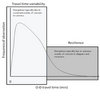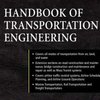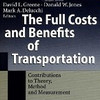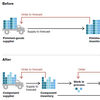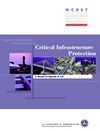 How can we assess how reliable or vulnerable the transportation is, and which parameters can we apply in measuring reliability and vulnerability? Transportation networks like freeways and interstate highways are the main backbone of modern society. Consequently, the reliability or vulnerability of any transportation network is thus a decisive factor not only in terms of market outreach and competition, but also in terms of continuity, to ensure a 24/7 operation of the community we live in. This research essay takes a closer look at vulnerability and reliability issues in transportation networks.
How can we assess how reliable or vulnerable the transportation is, and which parameters can we apply in measuring reliability and vulnerability? Transportation networks like freeways and interstate highways are the main backbone of modern society. Consequently, the reliability or vulnerability of any transportation network is thus a decisive factor not only in terms of market outreach and competition, but also in terms of continuity, to ensure a 24/7 operation of the community we live in. This research essay takes a closer look at vulnerability and reliability issues in transportation networks.
Acknowledgment
The issues listed in this essay were published on husdal.com in 2002 and were later cited by and incorporated into a research agenda for Critical Infrastructure Protection by the National Consortium on Remote Sensing in Transportation, see downloads section below.
This is the orginal English version of an article later translated into Norwegian: Pålitelighet og sårbarhet av transportsystemer.
Introduction
Transportation networks like freeways and interstate highways are the main backbone of modern society. Consequently, the reliability or vulnerability of any transportation network is thus a decisive factor not only in terms of market outreach and competition, but also in terms of continuity, to ensure a 24/7 operation of the community we live in. Any major accident or disturbance often illustrates not only how vulnerable the infrastructure itself, but serves also as a reminder of how easily freight transport, commuting and leisure travel can be perturbed, and how little it sometimes takes to question how reliably and safely one can use any means of transportation.
A risk and vulnerability study is a necessary step to assess the assumed vulnerability prior to any attempt to reduce vulnerability. This however, may often lead to differing views when a number of agencies, authorities and stakeholders are to agree on what is the most effective way to reduce vulnerability, and particularly, which vulnerability is the most important to reduce. This research will endeavor to outline a unifying framework that can comprise all other approaches towards reliability and vulnerability and develop a methodology for analysis and decision support that serves all stakeholders. At the same time, this research will also highlight how GIS can be utilized in order to both analyze and visualize the reliability and vulnerability of transportation networks.
As will be illustrated below, one can think of many approaches to define and express reliability and vulnerability, depending on the dominant point of view. Therefore, the ultimate aim of this research is to synthesize the different interpretations so that all sides of the vulnerability term can be taken into account in analyses and subsequent decisions. This paper is the first step towards a comprehensive and multi-disciplinary understanding of all sides of the term “vulnerability” as it pertains to transportation networks.
Risk and vulnerability defined
Berdica (2000) laments the lack of terminology pertaining to the vulnerability of road networks and proposes a theoretical framework for her own research: Although it may be convenient to define vulnerability as a problem of reduced accessibility, the theory pertaining to accessibility approaches the issue of vulnerability form the demand side. In reality, for analyzing vulnerability, the issue at hand is the supply side, meaning the actual existence of a functioning route from one location to the other. With this in mind, Berdica sets out the following definitions:
The serviceability of a link/route/road/network describes the possibility to use that link/route/road/network at a given time.
An incident is an event, which directly or indirectly may result in considerable reduction or interruption in the serviceability of a given link/route/road/network.
Risk is a composite of the probability of an incident to occur and the resulting consequences, should the incident occur.
Vulnerability of a road transportation system is the susceptibility to incidents that can result in a considerable reduction in road network serviceability.
Reliability is the complement to vulnerability and describes adequate serviceability under the operating conditions encountered at a given time.
With reliability as a complement to vulnerability, the issue of vulnerability can now be described in the well-established terms of reliability theory, where vulnerability in essence means non-reliability.
Measures of vulnerability
Finding one all-comprising measure of vulnerability and reliability is a daunting task, and the following compilation is not meant to be exhaustive; it’s merely meant to illustrate how complex this issue is and to highlight the questions that need to be raised and answered.
Traditionally, when looking at reliability of transportation networks, a systems engineering approach is used. Reliability is here dependent upon functioning or non-functioning links within the network, and may be defined as the degree of stability of the quality of service which a system normally offers. In Bell and Iida (1997), transportation network reliability is limited to two aspects only, videlicet, connectivity and travel time reliability. Although it conceptually makes perfect sense to sum up reliability in these two variables, there are an almost unlimited number of factors that may or may not contribute to the final value, and thus, should be part of the overall equation. Berdica (2000) laments this lack of terminology pertaining to the vulnerability of road networks and proposes to invert the commonly used reliability terminology such that non-reliability would mean vulnerability, and she applies this approach to a study in Stockholm, Sweden.
In the following the term reliability follows the description of Bell and Iiada, meaning functional integrity, whereas the term vulnerability will refer to the network’s susceptibility to loosing its functional integrity as described by Berdica.
As an example, let us think of a transportation network, made up of links and nodes, and consider how we can express vulnerability and reliability.
–Critical paths
If one or more of the links are taken out, the network flow is disturbed. If this link is absolutely necessary to get from a certain origin to a certain destination, then one might consider this part of the network to be vulnerable. This can be assessed using critical path and minimal cut calculations, see Bell and Iida (1997).
A network where many links are part of critical paths may be considered vulnerable. The question that needs to be solved is how many (rather: how few) critical paths make up how much vulnerability? How reliable is a network where many links are part of the critical path and how does one go about measuring this?
–Risk
An incident that can cause a link to close down is an incident that makes this link vulnerable. The risk of this happening is commonly defined as the product of probability and consequence, R = P * C. When analyzing risk, one is always faced with the differences between objective and subjective risk and the issue of risk acceptance level. Consequently, a “mathematical” increase in risk value may not necessarily mean an increase in actual vulnerability. In any case, an analysis of the various incidents which are most likely to occur along a link, and the risk of these, may provide valuable insights into the vulnerability of these particular links.
–Structural integrity
If the link that is taken out is a bridge, then to the engineer who built it, the vulnerability of the bridge is probably expressed in its structural integrity and its ability to withstand stress and external impact. The higher the ability to withstand potentially damaging incidents is, the less the vulnerability and the higher the reliability of the link is. Reliability is here a question of design. Today, most structures are built according to standards or building codes, and thus designed to withstand a certain load of stress before collapsing.
–Alternative routes
Traffic operation centers are probably not only concerned with the traffic on the actual link, but always looking for alternative routes, in case anything happens. As long as there exist alternative routing possibilities and as long as these have sufficient capacity to cope with the increased influx if traffic, the network at large is not vulnerable, and may be considered reliable. Capacity calculations for different scenarios will show for what circumstances this is or is not the case.
–Cost of rebuilding
The agency that is responsible for rebuilding infrastructure i.e. the State DOT, is of course concerned with the actual costs of rebuilding. Simply put, as a very crude measure, the greater the construction costs, the greater the vulnerability is. Economic calculations will have to be utilized here.
–Downtime
The general public, freight operators and commuters will worry about the time it takes for any downed link to be operable again. The longer the expected downtime is, say, because of rebuilding, the stronger the impact on the users of the link is. This implies the necessity of putting numbers to the socio-economic cost of loosing this link.
–Road class
The road class is also a major factor in determining vulnerability. It is after all more important to keep a freeway than a local access road operable. However, if this access road is the only way to or from the affected community, then this small and seemingly unimportant community becomes extremely vulnerable. Consequently, albeit road class may be an important weighting factor in a vulnerability analysis, meaning the higher the class, the higher the vulnerability towards certain incidents, it goes without saying that the importance of the road to the actual users should override any road class weighting factors.
–Hazardous materials transport
Investigating what can happen on the road is equally important to investigate what can happen to the road. Hazardous materials transport is only one consideration. One way of looking at this issue is to study both the type and amount of hazardous material that is transported and link it to traffic density and incident rate along the particular link. This relates reliability to the traffic rather then to the infrastructure, and makes the vulnerability to the users dependent on the users themselves.
–Traffic safety
If mitigation is to play a role in measuring vulnerability, then one might argue that vulnerability is dependent on the presence of such measures as lower speed limit, reinforced dividers, traffic control and monitoring devices. The question remains as to determining to what degree these measures contribute to an increase or decrease in vulnerability.
–Availability
What matters most to the users of the transportation network is its availability at the time of travel, in other words, can I get from A to B by using the intended route and means of transport, which would be the best case. Or, is there no route or means of travel at all that can take me from A to B, which would be the worst case. The probability of the network of being available, accessible and in fact usable may thus be used as a measure of reliability.
–Operations and maintenance
The availability of a network link is not only dependent on external factors, such as avalanches, flood, or any kind of accident; it is just as much dependent on road maintenance. A well-maintained road is more likely to be available at a given time, than a less-maintained road.
–Emergency preparedness
The preparedness for incidents in the transportation network has a major influence on whether this incident will develop into a severe disturbance or not. The degree of disturbance that one can expects, based on incident type, and prepared for this particular incident can then serve as a measure of vulnerability.
This small example serves as an illustration of how difficult, if not impossible, it can be to find a common understanding of vulnerability and reliability. The aim of this research is thus to look more closely at this seemingly chaotic picture and to come up with a methodological framework that allows to investigate all aspects of reliability of vulnerability of transportation networks, such that not only the existing vulnerability can be reduced, but such that it can serve as a model for transportation and community planning where the reduction of vulnerability and reliability are main ingredients. Such preemptive measures can save much future expenditure.
Risk communication
If measuring vulnerability and reliability is amounts to a difficult task, then communicating this measure is probably even more difficult. The general public and the users of the transportation system have most likely a different opinion on vulnerability then have the engineers, operators, planners and decision makers.
Most prominently, they will differ in their acceptance vulnerability. Good and comprehendible communication is a result of good visualization and portrayal of facts and uncertainties in the calculation of vulnerability. Measuring the uncertainty in the calculated reliability thus becomes as important as measuring the actual reliability itself (Aven, 2002). Besides investigating the realms of reliability and vulnerability, any research into this field will also have to deal with developing methods for communicating uncertainty.
Applications of GIS
Miller and Shaw (2001) provide an excellent overview and comprehensive description of where and how GIS is applicable within the field of transportation. Thinking of the vulnerability and reliability of transportation networks, two application realms are thinkable: analysis and visualization. Husdal (2001) demonstrated in general terms the hidden potential for a better understanding of risk and vulnerability by using visualization tools and techniques. The question is: does GIS provide the necessary set of tools for analyzing and visualizing reliability and vulnerability of transportation lifelines?
Husdal (2002) proposes a new methodology for finding the inherent risk in the transportation lifeline neighborhood, related to natural hazards in particular, and shows how these can be backtracked towards the road, thus determining a risk value for a particular stretch of road, i.e. an arc or link. Similarly, this approach of aggregating a complex and inter-dependent factors into one value, could also be used to determine a value for the reliability and vulnerability of a road segment or a network as a whole.
Berdica (1998-2001) promotes a promising approach by viewing vulnerability as the complement to reliability. However, she’s still grounded in the prevailing systems engineering approach of availability of non-availability of each link, and still very focused on how the flow on each link is affected. As such the degree to which the flow is perturbed is seen as a measure of vulnerability. This research aims to look beyond these measures, defining a number of non flow-related measures as vulnerability parameters. The question at hand is how can these parameters be put into use?
In traditional network analysis, finding the shortest path through a network is made possible by associating travel impeding or travel facilitating attributes with each network arc. If it were possible to link attributes of reliability and vulnerability to the network arcs in a similar manner, then a reliability and vulnerability analysis can be conducted with the same tools as a traditional network analysis, and GIS has found its place also in this realm. The challenge, however, will ore often than not be that the complex issues of reliability and vulnerability are difficult to aggregate into one single attribute, but will have to be split into separate components, similar to the listing in section 2. With this approach in mind, it should be feasible and possible to use GIS for both analysis and visualization of reliability and vulnerability.
Suggestions for research
To sum up the above-mentioned, the following suggestions can serve as objectives for future research:
- Expand the traditional framework of reliability analysis to complement risk and vulnerability of transportation lifelines.
- Develop a spatial framework and a systematic methodology for analysis of risk and vulnerability of transportation lifelines.
- Develop spatial and statistical measures of risk and vulnerability of transportation lifelines.
- Develop methods and standards for communicating and visualizing risk and vulnerability of transportation lifelines.
- Recommend measures to reduce the vulnerability of transportation networks.
- Recommend measures to increase the reliability of transportation networks.
Research questions
In particular, the following are some of the issues that must be addressed in the course of this research:
- Is it possible to aggregate the various measures of vulnerability/reliability into one single attribute value for each arc or link in the network?
- What spatial and non-spatial analysis methods are applicable?
- How should the various contributing factors be weighted in aggregating one summary value?
- How does weighting the various contributing factors influence the final result? Is, for example, a pairwise comparison matrix a feasible approach or do other weighting methods provide more accurate results?
- Is there a correlation between the reliability/vulnerability parameters such that it is possible to predict the reliability/vulnerability of road network based on only a few of these parameters?
Conclusion
Any analysis of the reliability and vulnerability of transportation networks is obviously marked by a strong focus on multidisciplinary work and will contain elements of civil engineering, remote sensing, statistics, probability theory, risk and reliability analyses, operations research, optimization, spatial analysis, emergency planning, traffic safety issues, to mention but a few. With such a broad view, the application of GIS in this field should be interesting for many involved, and almost impossible to limit. One thing that can be said for sure is that reliability and vulnerability of transportation networks is not something that is best confined to the realms of academic research, it is, after all, something that concerns us all, and thus, is something that should be accessible and comprehendible to us all. Consequently, using a GIS for analysis and visualization will make this field more accessible to the practitioners and the general public alike.
References
Aven, T., 1992, Reliability and Risk Analysis. Elsevier Publishing Company, London.
Aven, T., 2002, How to Approach Risk and Uncertainty to Support Decision Making. JohnWiley & Sons.
Bell, M.G.H., Iida, Y., 1997, Network Reliability, in: Transportation Network Analysis, John Wiley & Sons, pp.179-192.
Berdica, K., 1998, Vulnerability in the Road Transportation System – Overview and Availability of Historical Data (in Swedish), Report TRITA-IP AR 98-70, KTH, Stockholm, Sweden.
Berdica, K., 2000, Analysing vulnerability in the road transportation system. Report TRITA-IP FR 00-76, Royal Institute of Technology, Division of Transport and Location Analysis, Stockholm, Sweden.
Berdica, K., 2000, Vulnerability in the Road Transportation System – Interruptions in the Road Traffic System – Signals for the Future (in Swedish), Report TRITA-IP AR 00-80, KTH, Stockholm, Sweden.
Berdica, K., 2001, Simulating Road Traffic Interruptions – Does It Matter What Model We Use? Report TRITA-INFRA 02-002, KTH, Stockholm, Sweden
Abrahamsson, T., 1997, Vulnerability in the Road Transportation System – A Conceptual Study (in Swedish), Report TRITA-IP AR 97-53, Intitutionen för Infrastruktur og Samhällsplanering, KTH, Stockholm, Sverige.
Dalziell, E., & Nicholson, A. (2001). Risk and Impact of Natural Hazards on a Road Network Journal of Transportation Engineering, 127 (2), 159-166
Dalziell, A.; Wilkinson, D.L; Nicholson, A.J., 1999, Closure of the Desert Road due to snow and ice. IPENZ Transactions, 26, 1, 21-28
Husdal, J., 2001, Is it really that dangerous? Issues in visualization of risk and vulnerability. Unpublished coursework, University of Utah, Spring 2001.
Husdal, J., 2002, A spatial framework for modeling hazards to transportation lifelines, Unpublished, Presented at the AAG Annual Meeting 2002, Los Angeles, 19.-23.3.2002
Malczewski, J., 1999, GIS and Multicriteria Decision Analysis, John Wiley and Sons
Miller, H.J., Shaw, S.-L., 2001, Transportation, Environment and Hazards, in: Geographic Information Systems for Transportation, Oxford University Press, pp.341-379.
Downloads
- National Consortium on Remote Sensing in Transportation: Critical Infrastructure Protection
Related
- husdal.com: Reliability and vulnerability – a non-issue in cost-benefit analyses?
- husdal.com: Reliability and vulnerability versus costs and benefits (INSTR2004)
- husdal.com: Reliability and vulnerability versus costs and benefits (ETC2004)
- husdal.com: The reliability and vulnerability of road networks in a cost-benefit perspective
- husdal.com: Transport Network Vulnerability – which metrics should we use?
- husdal.com: Are roads more important than computers?


